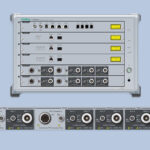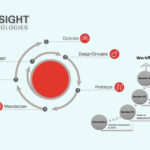ASIA ELECTRONICS INDUSTRYYOUR WINDOW TO SMART MANUFACTURING
ULVAC’s Vacuum Gauge Adopts New Method
ULVAC, Inc. has in its lineup measuring instruments for diverse applications, including semiconductors. Particularly, the two products the company released last year dramatically improved the ease of measurements. The company achieved the improvements by incorporating new functions in conventional models.
A vacuum gauge measures degree of vacuum by discharging gases inside equipment using a vacuum pump. Moreover, the Pirani vacuum gauges that use heat conductivity of gases are one of vacuum gauges that feature most high general versatility. They measure pressure of the low vacuum to medium vacuum region, and hence they can be used for a wide range of applications.

Features, Characteristics
In developing the SW100 Series vacuum gauge, ULVAC renewed the design of SW1, which the company ships more than 20,000 units annually. Particularly, SW100 has an expanded interface to support USB Type C. Hence, it can be connected to a smartphone and a personal computer.
Using dedicated UL-MOBI software improves the usability of SW100 in measurements. A set point, which outputs signals under a certain pressure, can be set simply by inputting a numerical value on the software.
Checking the status of SW100 at the occurrence of an error is also easy. Conventional models could only detect presence or absence of an error. However, SW100 displays error messages in the Status, allowing users to grasp causes of errors. It can also record measurement data, such as measurement time and pressure value.
SW100 also has output signals compatible with previous models. Selecting output signals on UL-MOBI eliminates the need to change setting of equipment even when replacing to the new model.
SW100 also features an impact resistant probe, which was also adopted in SW1. The probe has a mechanism that protects the filament from vibrations and shocks and hardly causes disconnection.

Pirani vacuum gauges best suit pressure measurements of furnaces used to sinter magnets for use in electric vehicle (EV) motors, as well as of manufacturing equipment for semiconductors and flat panel displays (FPDs). Their adoption in the drying process in EV battery manufacturing is also anticipated.
Monitor Film Thickness, Deposition Rate
The CRTM-R1/CRTM-R1-EL quartz crystal deposition controllers monitor film thickness and deposition rate during vacuum deposition to deposit materials. Particularly, metals, onto substrate in a high-vacuum state in real time, and control the deposition rate to be constant.
The weight of the film attached on the crystal plate reduces crystal resonator’s vibration frequency. In addition, the film thickness and deposition rate can be calculated from the amount of change. ULVAC manufactures crystal resonators in-house and sells them to external companies as well.
About 40 years on since the launch of a deposition controller, ULVAC has changed the measurement principle for the first time and adopted the impedance measurement method. Conventional CRTM deposition controllers measure resonance frequency by oscillating a crystal resonator. By contrast, CRTM-R1/CRTM-R1-EL measure resonance frequency by searching where is resonance frequency without oscillating a crystal resonator.
As a result, CRTM-R1/CRTM-R1-EL feature improved rate stability, and achieve uniform films. These models suppress oscillation abnormality during deposition, avoid stoppage of deposition process due to the reduction of film thickness and other factors, thus preventing the occurrence of production loss.
The life of crystal plate has also increased. In case of deposition using aluminum, the life of crystal plate has increased to about twice that of conventional models. Thus, the new models reduce costs and wastes.
They also measure resistance value of crystal plate as well as frequency, thus, detecting abnormalities of crystal plate.
Applications of deposition controllers for organic CMOS have been increasing, in addition to organic light-emitting diode (OLED) displays, smartphones, and power devices, such as silicon carbide (SiC) devices, according to ULVAC.




